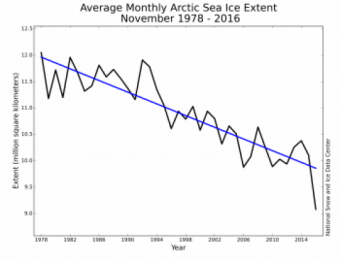 Average Arctic sea ice extent for November was the lowest on the satellite record, reflecting unusually high air temperatures, winds from the south, and a warm ocean. Antarctic sea ice extent quickly declined in November, also setting a record low for the month – in marked contrast to recent years. For the globe as a whole, sea ice cover was exceptionally low, according to the U.S. National Snow and Ice Data Center (NSIDC).
Average Arctic sea ice extent for November was the lowest on the satellite record, reflecting unusually high air temperatures, winds from the south, and a warm ocean. Antarctic sea ice extent quickly declined in November, also setting a record low for the month – in marked contrast to recent years. For the globe as a whole, sea ice cover was exceptionally low, according to the U.S. National Snow and Ice Data Center (NSIDC).
In November 2016, Arctic sea ice extent averaged 9.08 million square kilometers (3.51 million square miles). This is 800,000 square kilometers (309,000 square miles) below the previous record low in November 2006 – about the size of France and the United Kingdom combined.
At this time of year, air temperatures near the surface of the Arctic Ocean are generally well below freezing, but this year has seen exceptional warmth. For a brief period in the middle of November, total extent actually decreased by 50,000 square kilometres – an almost unprecedented occurrence for November over the period of satellite observations, according to NSIDC.
Continuing the warm Arctic pattern seen in October, November air temperatures were far above average over the Arctic Ocean and Canada. Air temperatures were locally up to 10 degrees Celsius (18 degrees Fahrenheit) above average near the North Pole, according to NSIDC. Europe’s Copernicus Climate Change Service also reported exceptionally warm temperatures in the Arctic.
This year, Antarctic sea ice reached its annual maximum extent on August 31, much earlier than average, and has since been declining at a fairly rapid pace. This Antarctic sea ice extent in November: NSIDC led to a new record low for the month of November over the period of satellite observations. Average extent in November was 14.54 million square kilometers (5.61 million square miles). This was 1.0 million square kilometers (386,000 square miles) below the previous record low of 15.54 million square kilometers (6.00 million square miles) set in 1986.
Part of the explanation for this appears to lie in changing wind patterns, with large large scale winds blowing north to south, tending to compact and compress sea ice, according to NSIDC.
“The processes governing the evolution of sea ice in both hemispheres is a result of different atmospheric and oceanic processes and geographies and it unlikely that record low conditions in the two hemispheres are connected,” said the NSIDC.
Source: public.wmo.int

